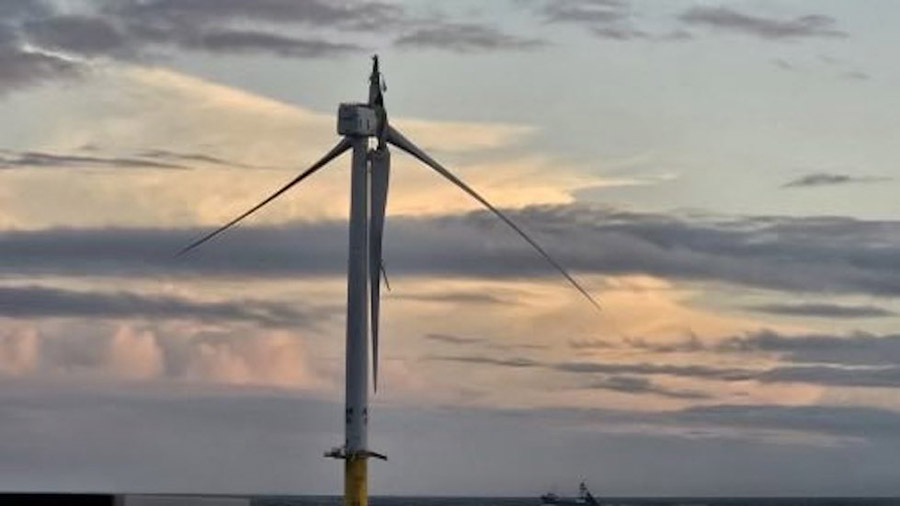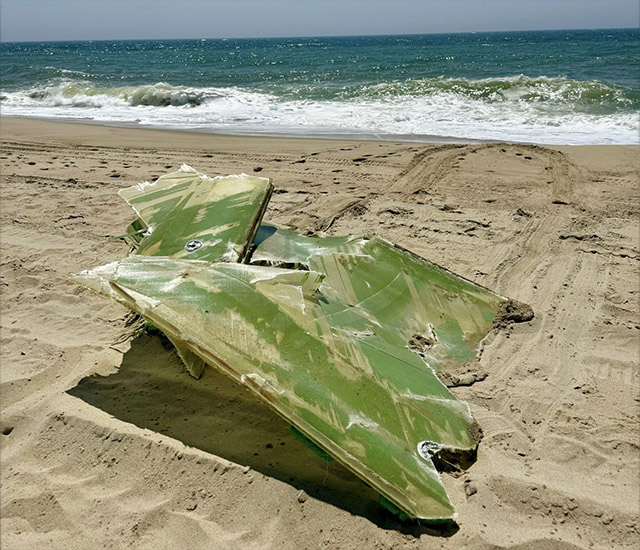Story updated on July 24
The July 13 collapse of a blade on an 853-ft-tall turbine at the giant Vineyard Wind offshore wind project off southern Massachusetts was due to a "manufacturing deviation," not design or engineering, Scott Strazik, CEO of turbine maker GE Vernova, told investors and analysts on July 24.
The estimated 351-ft-long, 57-ton blade broke about 65 ft "from the root," which connects it to the turbine rotor.
Investigations remain under way by the project's U.S. based turbine manufacturer and installer, as well as by the U.S. Interior Dept., of the incident that caused no injuries but sent large debris pieces, including foamboard and fiberglass shards, washing up on Nantucket Island, 21 miles north of the site. Officials of the 806-MW project now are managing cleanup, with construction and operation still suspended by the department's Bureau of Safety and Environmental Enforcement until "it can be determined whether the blade failure affects any other Vineyard Wind turbines," that agency said.
The estimated $3-billion project can do limited work such as underwater installation and certain surveys, with worker risk analysis and mitigation measures now mandated. Installation of cables and foundations continue at the site, said Ignacio Galan, chairman of Iberdrola, the parent of Vineyard Wind developer Avangrid, on a late July quarterly results update. Its joint venture partner is Copenhagen Infrastructure Partners.
"Our investigations to date indicate the affected blade experienced a manufacturing deviation" that was traced to a factory in Gaspé, Quebec, managed by GE Vernova business unit LM Wind, Strazik said on its second-quarter results call. The firm has not identified any evidence of an "engineering design flaw in the blade," he said, nor a link to a blade failure earlier this year on a similar turbine at the larger Dogger Bank wind project in the U.K. that was due to an installation error.
In a clarification, a GE Vernova spokesperson cited "insufficient bonding that the quality assurance program should have identified," as the plant production issue. "Our investigation is ongoing, and we are working with urgency to scrutinize our blade manufacturing and quality assurance program across offshore wind," the spokesperson said.
GE Vernova said July 22 the firm is "working with urgency to complete our root cause analysis,” but Strazik declined to offer a "timeline" for completion. He acknowledged "we have work to do" but told investors "we are going to be thorough instead of rushed.” GE Vernova had termed the incident an “isolated blade event” in an initial statement.
In a filing to the U.S. Securities and Exchange Commission, the manufacturer did not know when the federal operations halt would end or modify, and noted that potential liquidated damage claims for delayed completion "could be significant and adversely affect our cash collection timelines and contract profitability.”
Roger Martella, GE Vernova chief sustainability officer, told Nantucket officials at a meeting that the Vineyard Wind blade failure "is highly unusual and rare" but is not "an acceptable outcome" nor "something we want to see repeated."
While insurers are watching the event, it was "not a total shock," according to comments reported by sector publication Recharge, although budget and schedule impact remains to be seen with cost of the project's idled turbine installation vessel estimated at $350,000 per day.
Moving Forward
Vineyard Wind project start was long delayed by the Trump administration's refusal to approve its construction plan. The Biden Administration immediately okayed it, with the first turbine installed by mid-2023. As of July, about 24 of its planned 62 turbines were installed, with 10 that were operating to produce about 136 MW of power and 47 turbine foundations installed with their transition pieces.
The damaged turbine was still in testing and not in operation, Vineyard Wind said. In previous statements, the developer said "a significant part of the remaining GE Vernova blade detached from the turbine," adding that it is "staying apprised of [the manufacturer's] efforts to manage the situation, including removal and recovery of the remaining blade attached to the turbine."
The developer said it was concerned that while "a fleet of vessels remains at sea ... working to remove bulk debris," the blade remnant could could detach "soon," in difficult ocean weather conditions. "We have deployed additional crews to Nantucket Island in anticipation that more debris could wash ashore tonight and tomorrow as we continue to monitor additional coastal communities."
Nantucket on July 23 released an initial environmental assessment of the incident completed by engineering firm Arcadis for GE Vernova, which indicates the consultant also will be involved to detach blade pieces still attached to the turbine.
The updates followed a packed July 17 briefing by Vineyard Wind CEO Klaus Moeller to the Nantucket Select Board that elicited major concerns from board members, local officials and residents, according to one local report. The developer said it "remains focused on ensuring the safety of personnel and mariners in the offshore area," and said there has been no harm to marine life or resources. The firm and U.S. Coast Guard are maintaining a safety zone of 500 meters around the damaged turbine. Nantucket beaches initially closed but were reopened, Vineyard Wind said.


Cause of damage to GE Vernova large wind turbine at 806-MW Vineyard Wind offshore wind project off southern Massachusetts (top), which sent debris washing up on nearby Nantucket Island, (above), is under investigation.
Images: top, courtesy of Nantucket Current via X (Twitter); above, courtesy of Town of Nantucket X (Twitter)
Vineyard Wind said it has contracted Robert B. Our Co Inc., a Harwich, Mass., construction firm, and National Response Corp., an emergency response contractor, to lead cleanup operations. The developer said that as of July 17, it had removed 17 cu yd of debris.
The Nantucket Current said it was told by Vineyard Wind that "three newly manufactured replacement blades were installed on this GE Vernova wind turbine after one of the original blades for the turbine was damaged during the lifting process and subsequently removed from the construction area."
Vineyard Wind is developing a process for financial claims, which it has not yet unveiled, although Nantucket officials are also weighing legal action. said Nantucket Current.
One market analyst speculated that this and other recent similar incidents may be due to rapid turbine capacity scaleup in recent years by western and Chinese manufacturers, from 8 MW to 15 MW and higher.
“This rapid scaling brings immense engineering challenges,” said Indra Mukherjee, associate research director for clean energy technology at S&P Global Commodity Insights. “The constant push for larger blades leaves little time to build a reliable track record, identify failure modes and implement fixes.”
While 20,000 turbines ordered in 2023 have had low failure rates, said the researcher, "blades have become a significant vulnerability,” with all major manufacturers having faced "breakages.” As a result, they "are slowing new product launches," with added focus on refining and industrializing existing technologies, Mukherjee added.
The Vineyard Wind break “should not have happened and represents a highly unusual event,” said Eric M. Hines, who directs the offshore wind graduate engineering program at Tufts University in Medford, Mass. “These are built to take hurricane-force loads.” But it “reinforces the need to shift focus … to establishing the industry and its supporting infrastructure on a footing that can deliver the energy transition at scale. This accident will reinforce … that offshore wind is held to higher standards than other energy industries.”
Keeping Momentum
Despite the incident, both GE Vernova and Avangrid parent Iberdrola reported improved results in just announced quarter updates. The manufacturer noted some weakness in its wind power business but said its second quarter loss was less than in the previous quarter and overall earnings were well above market expectations. Iberdrola raised its guidance to forecast "double digit net profit growth" for its fiscal 2024, said Chairman Galan, who noted "record renewables production and robust performance" for the first half.
Offshore wind energy development elsewhere in the U.S. also got a mid-summer boost.
Utility firm Dominion Energy, now building its 2.6-GW, $9.8-billion Coastal Virginia Offshore Wind (CVOW) project off Virginia Beach, is set to expand in an announced $160-million plan to buy development rights for an adjacent offshore wind zone off the North Carolina coast owned by developer Avangrid. The 162-sq-mi area, to be renamed CVOW South, could generate 2.4 GW of power, Dominion said, with the deal setr to close in late 2024. Dominion CEO Bob Blue said electric demand in the utility's territory would double in the next 13 years. CVOW construction, begun in May, is set to finish in 2026.
Also, South Korea-based LS Cable & System picked Chesapeake, Va., for a $680-million, 750,000-sq-ft factory for high voltage, direct current subsea cables, which it says will be the largest of its type in the U.S. and one of the largest standalone offshore wind supply chain investments.
Construction would begin in 2025, with startup by late 2027. Unit LS GreenLink USA, which has gained about $147 million in state and federal incentives, has yet to name a contractor for the plant but “is about to announce our pick,” Managing Director Patrick Shim told ENR.
Delaware lawmakers also passed a bill in July to require the state to buy offshore wind power for its public utilities, and Interior Dept. officials approved for construction the 2.6-GW New England Wind project off Massachusetts’ coast and the 2.8-GW Atlantic Shores facility off New Jersey. Atlaniic Shores, and developers Community Offshore Wind and Attentive Energy met a July 17 deadline to submit bids to the state Board of Public Utilities for power contracts.
in a key move, the California Energy Commission on July 10 okayed a final state plan to achieve an interim goal of 5 GW of floating offshore wind capacity by 2030 and 25 GW by 2045. State lawmakers also passed a bond measure that includes $475 million for offshore wind ports and $325 million for clean energy transmission.
Flexibility
Interior also aimed to boost the market, enacting a new regulation that took effect on July 14—the Renewable Energy Modernization Rule, or "mod" rule, which streamlines permitting and provides more regulatory certainty to developers, said S&P Global. It is "the first major attempt to reform offshore wind regulations in the US since they were first put into place in 2009," said the market researcher. Key provisions include longer leases, revised financial assurance requirements, guidance on shared transmission and more flexibility on reporting requirements and data collection. S&P analysts said the reforms "could lead to industry cost savings of $1.6 billion over the next 20 years," an estimate they said is "more than 20% higher" than the federal cost-cut estimate.
U.S. developers are set to invest $65 billion in offshore wind projects by 2030, reaching 14 GW, says a new American Clean Power Association report. While that prediction is a miss for the Biden Administration goal of 30 GW by 2030. that capacity is set to be reached by 2033, the group contends.
New York also is set to miss by three years its nation-leading goal set in 2019 of 70% renewable energy generation by 2030, with a spate of recent offshore wind project cancellations, said a new state report. There is speculation officials could reset the goal to 2033.
“What we are proposing here is literally an assessment of the interventions and adjustments and essentially actions to maximize our progress toward this goal,” said Doreen Harris, president and CEO of the New York Energy Research Development Authority. “Clearly the world has shifted significantly since 2019 in directions that produce, I’d say, both headwinds and tailwinds in this program.”





